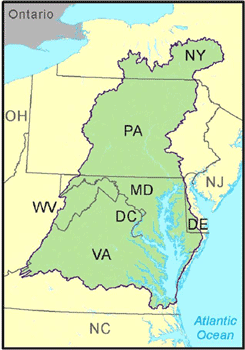Master Gardener Training Series: Water Wise Landscaping for the Chesapeake Bay Watershed
Image Source Chesapeake Bay Watershed
Did you know that the Chesapeake Bay Watershed is on a diet? It’s called the TMDL diet or Total Maximum Daily Load. This diet is a prescription for a healthy water system. We all play a part in the health and well-being of the Chesapeake Bay Watershed or whatever watershed you may live in. News flash, everyone lives in a watershed. I naively did not know that…ooops, but now I do and I feel extremely passionate about the subject. We can do our part by practicing water wise landscaping.
Here is an overview of what I learned during my Hanover Master Gardener Association Training through Virginia Cooperative Extension. Our speaker was Laurie Fox from the Hampton Roads Agricultural Research and Extension Center.
Quick Facts about the Chesapeake Bay Watershed:
The Chesapeake Bay Watershed encompassed 64,000 square miles of the East Coast
It’s comprised of 6 states and the District of Colombia
Home to more than 3,700 species of plants, fish and other animals
18 million people with a growth rate of 130,000 per year live in the Chesapeake Bay Watershed
The Chesapeake Bay TMDL is the largest regulatory document that the EPA has ever created of this type.
Storm water collected through public drainage systems does not go through a water treatment facility. It is directed to a water source that eventually spills into the Chesapeake Bay.
90% of sub-watersheds have impaired waters
What does the Total Maximum Daily Load (TMDL) diet monitor?
The Environmental Protection agency (EPA) passed the TMDL pollution diet in 2010. TMDL looks at the amount of sediment, excess nutrients, and other types of pollution that enter the watershed.
NASA Image of Sediment Cloud in the Chesapeake Bay Image Source
Sediment- It’s a problem because it covers aquatic grasses and plants and kills them because they can not photosynthesis and create the chlorophyll they need to survive.
Excess Nutrients- Phosphorus and Nitrogen specifically are monitored as they are the main cause of algae blooms. Algae blooms cause oxygen deprivation to the water when they die off which affects fish, crab, and other aquatic life.
Other Pollution- Pesticides, herbicides, pharmaceuticals, aquatic weeds, gas, oil, metals, etc.
The government has done a good job of controlling source point pollution into the Chesapeake Bay. Source point pollution is pollution that can be directly identified or pinpointed. An example of this would be a tanker truck turning over and dumping it’s contents into the waterway or a farmer spraying excess nutrients on their fields that then run off or leach into the waterway. We know an exact cause for these pollutants. What the government hasn’t figured out is how to control non-point source pollution. Non-point source pollution can’t be pin-pointed and defined. It just happens through widespread contributions that can’t be identified specifically. The number one source of non-point source pollution is homeowners. I found it fascinating that in the state of Maryland, home owners must present a soil test when purchasing Phosphorus based fertilizers. They must show a need for this nutrient before they are able to apply it to their yard.
How can I practice Water Wise Landscaping to help protect the Chesapeake Bay Watershed?
Perform a site analysis. Walk your property and determine where you may have drainage issues, and where you have bare soil. Is stormwater moving the way it should on your property?
Install smart irrigation. Don’t just set your system and forget it. Adjust your system based on the weather (some systems can do this for you). Consider drip irrigation. Adjust sprinkler heads so they are only watering pervious surfaces. Perform regular maintenance on your system.
Maintain healthy soil and plants. Aerate your turf yearly. Eliminate bare ground. Choose native plants. Ensure the right plant, the right place so that your plants will thrive and be well adapted to the conditions you place them in.
Practice responsible nutrient management. Perform regular water and soil tests. If you don’t want to do this for your turf, choose a maintenance-style, phosphorus-free fertilizer. You know that it is phosphorus-free by reading the label. It’ll list it on the back with the other ingredients and on the front of the bag you’ll find the NPK (Nitrogen, Phosphorus, and Potassium) values. The middle number will be zero. Ex. 9-0-2. Also, be sure that you are applying the fertilizer and the right time keeping upcoming rain weather events in mind before application. Slow-release fertilizers can be a better choice as they are less water-soluble than other types of fertilizers. Additionally, picking up your pet waste also keeps pathogens and pollutants out of the waterway.
Manage your stormwater run-off. You can do this by keeping three easy principles in mind. Slow it down. Spread it out. Soak it in. This can be accomplished in the following ways:
Rain Barrel- ½ inch of rain on a 1000 sqft. roof= 600 gallons of water collected
Permeable Paving- great, but difficult and expensive; may not be appropriate for your site and soil conditions
Rain Chains- slow down water
Buffers are absolutely necessary around bodies of water- they slow down pollutants, filter water, etc. loads of benefits to a buffer (coco coir logs can accomplish this)
Canopy Layers- Ex. NYC Street Tree Project; they slow down their water through extensive tree management practices.
Floating Wetlands
Living Shorelines
Rain Gardens- Slow down and filter rainwater and support wildlife
Resources for how to design a rain garden and more:
As always, feel free to reach out with any questions you may have. We’ve only scratched the surface on clean water and it’s so important that we all stay vigilant with this topic. No clean water = no life. Thanks for reading every week. It is an absolute pleasure putting these posts together.
Keep Blooming,
Nicole Dillon, Breemar Flower Farm






